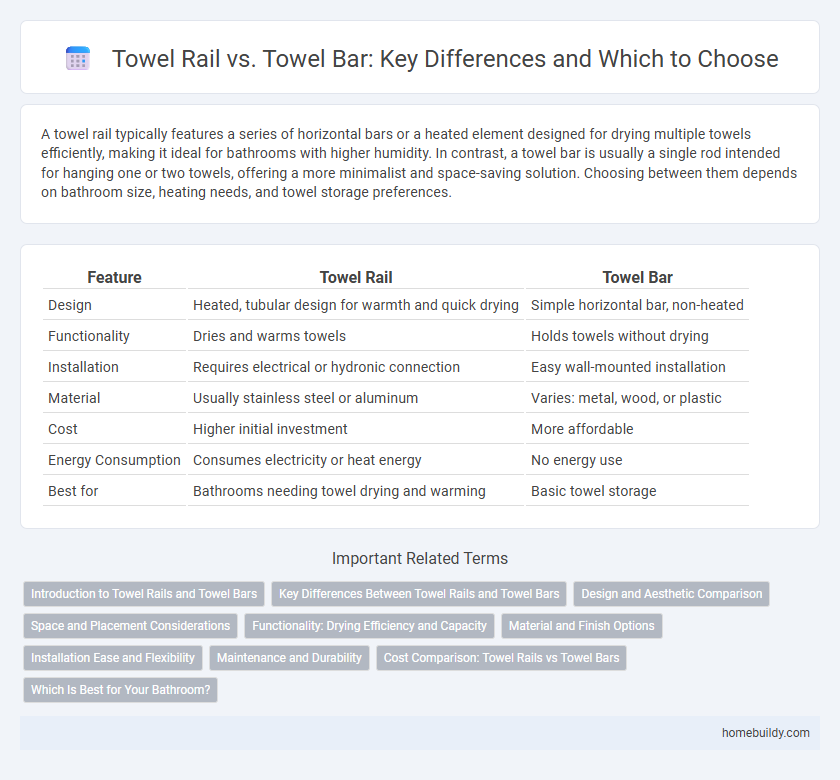A towel rail typically features a series of horizontal bars or a heated element designed for drying multiple towels efficiently, making it ideal for bathrooms with higher humidity. In contrast, a towel bar is usually a single rod intended for hanging one or two towels, offering a more minimalist and space-saving solution. Choosing between them depends on bathroom size, heating needs, and towel storage preferences.
Table of Comparison
| Feature | Towel Rail | Towel Bar |
|---|---|---|
| Design | Heated, tubular design for warmth and quick drying | Simple horizontal bar, non-heated |
| Functionality | Dries and warms towels | Holds towels without drying |
| Installation | Requires electrical or hydronic connection | Easy wall-mounted installation |
| Material | Usually stainless steel or aluminum | Varies: metal, wood, or plastic |
| Cost | Higher initial investment | More affordable |
| Energy Consumption | Consumes electricity or heat energy | No energy use |
| Best for | Bathrooms needing towel drying and warming | Basic towel storage |
Introduction to Towel Rails and Towel Bars
Towel rails and towel bars serve as essential bathroom accessories designed to hang and dry towels efficiently. Towel rails typically feature multiple bars or a heated element for faster drying and added warmth, while towel bars are usually single horizontal bars focused on simple towel storage. Understanding the differences in design, functionality, and installation options helps in selecting the ideal solution for bathroom organization and comfort.
Key Differences Between Towel Rails and Towel Bars
Towel rails are designed primarily for heating towels, featuring built-in heating elements that dry and warm towels efficiently, whereas towel bars are simple rods meant only for hanging towels without heating functionality. Towel rails often require electrical or plumbing connections, making them more complex to install compared to the straightforward mounting of towel bars on walls. The materials and design of towel rails focus on thermal conductivity and durability under heat, while towel bars prioritize aesthetic versatility and ease of use.
Design and Aesthetic Comparison
Towel rails offer a sleek, contemporary design with horizontal or vertical bars that provide a minimalist and streamlined aesthetic, ideal for modern bathrooms. Towel bars typically feature a single horizontal rod with a more traditional look, often suited for classic or rustic bathroom styles. The choice between a towel rail and towel bar impacts the bathroom's visual appeal, with towel rails enhancing spaciousness and towel bars delivering a simple, functional charm.
Space and Placement Considerations
Towel rails offer a space-saving solution by holding multiple towels at once, ideal for compact bathrooms with limited wall area. Unlike towel bars, towel rails can be vertically mounted, maximizing vertical space and allowing for better airflow and faster drying. Strategic placement of towel rails near showers or sinks enhances convenience without occupying valuable countertop or floor space.
Functionality: Drying Efficiency and Capacity
Towel rails offer superior drying efficiency due to their larger surface area and heated design, which accelerates moisture evaporation compared to traditional towel bars. The extended length and multiple bars in towel rails increase drying capacity, allowing several towels to be dried simultaneously without overlapping. In contrast, towel bars typically support only one towel at a time, limiting airflow and prolonging drying times.
Material and Finish Options
Towel rails typically feature tubular designs made from stainless steel, chrome, or brass, offering durability and resistance to moisture, whereas towel bars often come in flatter or more decorative styles using materials like aluminum or coated metals. Finish options for towel rails include polished chrome, brushed nickel, matte black, and antique brass, providing both modern and classic aesthetics that complement bathroom fixtures. Towel bars also offer a variety of finishes such as satin chrome and oil-rubbed bronze, but towel rails generally prioritize robust, corrosion-resistant coatings to withstand frequent exposure to steam and water.
Installation Ease and Flexibility
Towel rails offer greater installation flexibility due to their longer size and multiple mounting points, making them ideal for larger towels and varied bathroom layouts. In contrast, towel bars are typically simpler to install but better suited for smaller spaces and lighter towel loads. Choosing between the two depends on bathroom size and the desired towel capacity.
Maintenance and Durability
Towel rails typically feature a tubular design with heating elements that require occasional electrical or plumbing maintenance to ensure optimal functionality, while towel bars are simpler, fixed fixtures demanding minimal upkeep. The durability of towel rails often depends on the quality of materials and heating components, with stainless steel models resisting corrosion better over time compared to basic metal towel bars. Regular inspection of electrical connections and cleaning of heating surfaces prolongs the life of towel rails, whereas towel bars mainly need checking for loose fittings or rust in humid environments.
Cost Comparison: Towel Rails vs Towel Bars
Towel rails generally cost more than towel bars due to their larger size and integrated heating options, with prices ranging from $50 to $300 compared to $15 to $70 for standard towel bars. The installation cost for towel rails can also be higher because of electrical wiring or plumbing for heated models, whereas towel bars typically require simple wall mounting. Budget-conscious buyers often prefer towel bars for their affordability and ease of installation, while towel rails offer enhanced functionality at a premium price point.
Which Is Best for Your Bathroom?
Towel rails provide efficient heat distribution, drying towels faster and reducing dampness, making them ideal for bathrooms with limited ventilation. Towel bars offer a simpler, more cost-effective solution for hanging towels without heating, suitable for minimalist or budget-conscious designs. Choosing between a towel rail and towel bar depends on your bathroom's size, heating needs, and style preferences to maximize comfort and functionality.
Towel rail vs Towel bar Infographic

 homebuildy.com
homebuildy.com